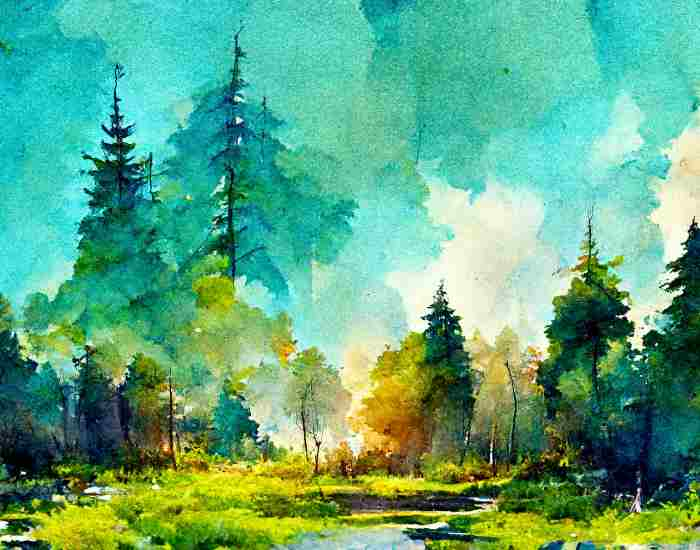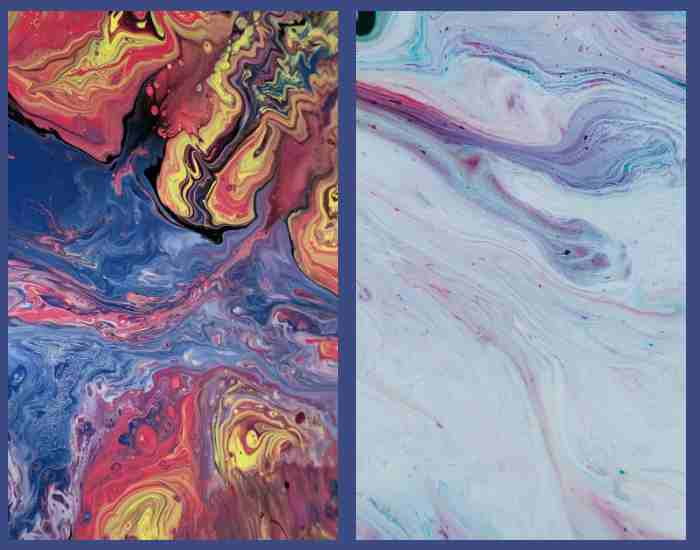Embarking on the mesmerizing journey of watercolor painting as a beginner opens the door to a captivating world of artistic expression. The sheer fluidity of watercolors transforms the canvas into a playground for your creativity, making it an ideal medium for those who are just starting to explore their artistic side.
For those new to the realm of art, the term watercolor paintings might evoke images of ethereal landscapes, vibrant florals, or abstract creations. The beauty lies in the versatility of this medium, catering to a spectrum of artistic preferences. Whether you’re intrigued by the subtlety of easy watercolor techniques or eager to dive into more intricate forms of watercolor painting, the options are as vast as your imagination.
As a novice artist, the prospect of wielding a brush and navigating the spectrum of hues might seem a bit daunting, but fear not. The allure of watercolor painting lies in its forgiving nature, allowing room for experimentation and growth. It’s a medium that encourages exploration and embraces imperfections, making it an ideal starting point for those at the beginning of their artistic journey.

Watercolor Techniques for Beginners
The wet-on-wet technique is a fundamental approach in watercolor painting that introduces beginners to the enchanting world of seamless blends and soft transitions. Imagine your canvas as a playground where colors dance together in a harmonious ballet, creating ethereal and captivating effects.
In this technique, the paper is dampened before applying the paint. The wet surface allows the colors to meld and flow into one another, producing beautiful gradients and organic patterns. As a beginner, this method provides you with a range of creative possibilities, offering a smooth learning curve that aligns perfectly with your artistic journey.
The above options are vast when it comes to choosing colors for your wet-on-wet creations. You can opt for a dreamy pastel palette for a serene landscape or go bold with vibrant hues for a lively abstract composition. The beauty of this technique lies in its versatility, enabling you to experiment and discover your unique artistic voice.
Choosing the right watercolor paper is crucial for the success of the wet-on-wet technique. A heavier paper, such as cold-pressed or rough watercolor paper, absorbs and holds the water, allowing you to manipulate the paint more effectively. This ensures that your creations not only look stunning but also stand the test of time.
Developing your watercolor painting skills with the wet-on-wet technique is akin to conducting an orchestra of colors. As you become more familiar with the process, you’ll find joy in the unpredictability and spontaneity that this method brings to your artwork. Embrace the magic of wet-on-wet, and let your imagination flow freely across the wet canvas.
Dry Brush Technique
Contrasting the fluidity of wet-on-wet, the dry brush technique introduces a textured and detailed dimension to your paintings. This method involves using a brush with minimal moisture, allowing the bristles to graze the dry surface of the paper.
The result is a captivating interplay of light and shadow, with the dry brush capturing the paper’s texture, creating a visual feast for the viewer. It’s a technique that lends itself well to creating intricate details, making it particularly suitable for adding depth to elements like foliage, fabric, or intricate patterns.
Imagine crafting a scene where a human silhouette stands out against a mesmerizing backdrop. The dry brush technique is your ally in bringing this vision to life, as it allows you to articulate the fine details of the silhouette with precision. Similarly, for portraying the grace of an animal silhouette or the mysterious allure of a moonlit background, the dry brush technique offers a tool for nuanced expression.
Experimenting with the dry brush can lead to remarkable results in creating a compelling silhouette composition. It provides a sense of control over the brushstroke, empowering you to define the edges and details of your subjects with finesse. As you delve into the world of dry brushing, you’ll discover its potential to elevate your watercolor paintings to new heights, adding a tactile and dimensional quality that captivates the observer.
Creating vibrant landscapes
In the realm of watercolor painting, creating vibrant landscapes is a thrilling adventure into the world of colors. As a beginner, understanding how to use different colors effectively can transform your canvas into a captivating scene that evokes emotions and tells a story.
Guidance on using watercolor paints is your first step towards crafting landscapes that come alive. Experimenting with a diverse palette, ranging from the subtle hues of a sunrise to the bold colors of a sunset, allows you to convey the mood and atmosphere of your chosen scene. Understanding how to layer and blend these colors will enable you to capture the essence of a captivating landscape.
Different colors play a crucial role in depicting the various elements of your landscape. From lush greenery to serene bodies of water, each color contributes to the overall composition, creating a harmonious visual experience. As a beginner, embracing the vast spectrum of colors available to you opens up endless possibilities for expressing the beauty of the world around you.
Exploring Floral Watercolors
Watercolor flowers hold a special allure, and exploring floral watercolors is a delightful journey into the delicacy and vibrancy of nature. As you embark on this creative exploration, consider infusing your artwork with the subtlety of simple shapes and the allure of the silhouette effect. watercolor.
Tips for capturing the delicacy of flowers extend beyond traditional representation. Embrace the challenge of portraying a real object in the form of a flower, understanding how light differs when illuminating petals and leaves. Experimenting with different techniques allows you to bring your flowers to life, whether through intricate detailing or the bold strokes of creative pastel paintings.
Simple shapes become the building blocks for your floral compositions. Each brushstroke contributes to the graceful dance of petals and the elegant curvature of stems. The silhouette effect. Watercolor adds a touch of mystery and sophistication, allowing you to play with contrasts and create visually striking floral arrangements.
- More Post: 7 principles of design in art, with examples
- More Post: Canva vs. Photoshop: Which Design Tool Should You Use?
Experimenting with shapes
Silhouette Art
Silhouettes are a powerful tool in the arsenal of a watercolor artist, offering a unique way to add drama and simplicity to your artwork. As a beginner, understanding how to effectively utilize silhouettes can elevate your compositions, turning them into captivating visual narratives.
When used with finesse, silhouettes can be a great way to create impactful scenes. Imagine a lone figure against a vibrant sunset, or a tree silhouette casting long shadows across a landscape. Silhouette art has the ability to evoke emotions and tell stories with just the outline of shapes. It’s a technique that allows you to play with contrasts and highlights, creating a dynamic visual experience.
Experimenting with silhouettes opens the door to fun composition possibilities. Consider a scene where a figure with an umbrella stands against the backdrop of a rainy cityscape. The simplicity of the silhouette adds a touch of mystery and intrigue, inviting the viewer to interpret and engage with the artwork. Silhouettes, when used creatively, can also become a painting stand for conveying themes and messages in a visually impactful way.
Adding silhouettes to your watercolor paintings provides an opportunity to explore different sources of inspiration. Whether it’s a figure against a sunset or the silhouette of trees casting reflections on water, these elements can create ripples that create a ripple effect of interest and engagement in your artwork.
Abstract Shapes
For those seeking a more avant-garde approach, abstract shapes offer a refreshing avenue for artistic expression. Encouraging beginners to embrace abstract forms can lead to truly unique and personal compositions that break free from conventional norms.
Experimenting with paper. silhouettesimage allows you to push the boundaries of traditional art forms. Use cut-out shapes to create intricate stencils that introduce new dimensions and textures to your watercolor paintings. Explore the interplay of positive and negative space, allowing geometrical patterns to emerge and become an integral part of your artistic narrative.
Embracing abstract art is liberating, as it frees you from the constraints of realistic representation. It encourages you to play with colors, shapes, and forms in unexpected ways, fostering a sense of spontaneity and creativity. Whether it’s exploring geometrical patterns or allowing the brush to dance freely across the canvas, abstract shapes become a vehicle for conveying emotions and ideas beyond the confines of literal interpretation.
Step-by-Step Sky Painting
Creating a stunning watercolor sky is a delightful and rewarding endeavor for artists of all levels. In this step-by-step tutorial, we’ll guide you through the process of bringing the heavens to life on your canvas.
Images, source images, or image source images are excellent starting points for inspiration. Begin by observing the nuances of the sky, noting the colors and gradients that captivate your imagination. Whether it’s the warm hues of a sunrise or the cool tones of a twilight sky, understanding the essence of the sky is crucial.
- Prepare your palette. Select a range of colors that mirror the sky you want to depict. For a sunset, include warm oranges, reds, and purples; for a daytime sky, opt for various shades of blue.
- Wet Your Paper: Dampen your watercolor paper slightly. This prepares the surface for the blending of colors and allows for smoother transitions.
- Base Layer: Start with a light wash of the primary color of your sky. This sets the foundation for the overall mood.
- Build Gradually: Layer additional colors, working from light to dark. Blend the colors while the paper is still wet to achieve a seamless transition.
- Add Details: As the sky takes shape, add details like clouds. Use a damp brush to create soft edges, mimicking the natural look of clouds.
- Let it Dry: Allow your masterpiece to dry completely. Watercolors often present delightful surprises as they dry, so exercise patience and let the magic unfold.
Remember, each sky is unique, offering a canvas for your interpretation and creativity.
Leaves and Foliage
Painting realistic leaves and foliage is a wonderful way to connect with nature through art. This step-by-step tutorial will walk you through simple techniques to bring the beauty of leaves to your watercolor paintings.
- Choose Your Foliage: Decide on the type of leaves you want to paint. Different leaves have unique shapes and structures, so observe the ripples of inspiration.
- Select Your Palette: Pick colors that reflect the natural hues of leaves. Greens, yellows, and browns are typically essential, but don’t shy away from adding unexpected touches to make your foliage stand out.
- Brush Techniques: Experiment with different brush strokes to capture the varied textures of leaves. Use a fine brush for intricate details and a broader brush for broader strokes.
- Layering: Begin with the lightest color as your base layer. Gradually layer darker colors to build depth and dimension. Allow each layer to dry before adding the next.
- Veins and Details: Once the base layers are dry, add veins and details to mimic the intricacies of leaves. A steady hand and attention to detail will bring your foliage to life.
- Incorporate Background: Consider the environment your leaves inhabit. Adding a background, even a simple one, can enhance the realism and context of your foliage.
Watercolor painting for beginners is more than just an artistic pursuit; it’s a journey of self-discovery, a pathway to embrace the joy of creating. As you navigate the fascinating world of watercolors, remember that each stroke, each experiment, contributes to your unique artistic voice.
Embracing the Joy of Creating
The beauty of watercolor painting lies in its forgiving nature, inviting you to experiment with different ideas and techniques. Whether you’re exploring the interplay of colors, mastering various brush strokes, or delving into the world of silhouettes and abstract shapes, each exploration is a step toward discovering your personal style.
No Mistakes, Only Opportunities for Growth
As a beginner, it’s essential to understand that there are no mistakes in watercolor painting, only opportunities for growth. Embrace imperfections as part of the artistic process, and view challenges as stepping stones toward improvement. Each stroke teaches you something new, shaping you into a more confident and skilled artist.
A Tapestry of Techniques and Styles
The world of art is vast, and as you embark on your journey, consider exploring the techniques and styles of seasoned watercolorists. Learn about composition, color theory, and the color wheel to deepen your understanding of the craft. Drawing inspiration from painters who have mastered the medium can broaden your artistic horizons.
While watercolors offer a magical canvas for your creativity, don’t hesitate to venture into other realms of art. Experiment with acrylic painting, gouache, or even combine mediums to create unique and captivating pieces. The skills you acquire in watercolor painting can serve as a solid foundation for exploring diverse artistic expressions.
Just as there are infinite colors in your palette, there’s a rich diversity in the world of paintings. From serene watercolor paintings to bold acrylic masterpieces, each artist contributes to the tapestry of artistic expression. Celebrate the differences, and let the varied strokes of fellow artists inspire and motivate you on your creative journey.
In conclusion, watercolor painting for beginners is not just about creating visually stunning artworks; it’s about self-expression, growth, and finding joy in the process. As you continue to explore, experiment, and create, remember that your artistic journey is uniquely yours, and the canvas is limitless with possibilities. Cheers to the joy of creating and the endless opportunities for artistic growth!





